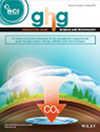Abhishek Gupta, Akshoy Ranjan Paul, Anuj Jain, Ramesh K. Agarwal
求助PDF
{"title":"A Study on Effect of Number of Low-Permeability Layers on Geological Carbon Sequestration in an Open Aquifer","authors":"Abhishek Gupta, Akshoy Ranjan Paul, Anuj Jain, Ramesh K. Agarwal","doi":"10.1002/ghg.2334","DOIUrl":null,"url":null,"abstract":"<div>\n \n <p>The use of fossil fuels to fulfill energy demand is responsible for CO<sub>2</sub> emissions, resulting in global warming and climate change. Despite the expansion in renewable energy sources, energy combustion and industrial processes caused a 0.9% increase (321 Mt) in global CO<sub>2</sub> emissions to a record high of 36.8 Gt in 2022. Carbon capture and sequestration (CCS) technology can allow the use of fossil fuel without damaging the environment by storing CO<sub>2</sub> underground, paving the way for a sustainable, low-carbon future. Without fracturing, both homogeneous and low-permeability aquifers can safely accommodate injected CO<sub>2</sub>. This study investigates the effect of low-permeability layers composed of sandstone and shale layers on the capacity and performance of CO<sub>2</sub> storage in open saline aquifers. The CO<sub>2</sub> migration, dispersion, and reservoir pressure variations have been numerically investigated in a computational domain representing the Utsira Formation in Sleipner CCS project. In a homogeneous aquifer, rapid vertical migration results in 65% of the injected CO<sub>2</sub> accumulating at the top layer after 30 years. However, the presence of four low-permeability layers reduces this accumulation to 58% over the same period, demonstrating enhanced trapping efficiency. Long-term simulations indicate that CO<sub>2</sub> accumulation at the top surface increases to 75% of the total injected volume over 80 years. CO<sub>2</sub> dissipates and migrates over time, resulting in a decrease in surface pressure. Pressure analyses reveal that the peak injection-induced pressure remains within the fracture pressure limit (20–25 MPa), ensuring safe storage. After 30 years of injection, pressure at the top surface drops by 0.27 MPa (2.72%) within 2 years post-injection and continues to decrease gradually. This investigation contributes to a better understanding of the dynamics of CO<sub>2</sub> storage in open saline aquifers, thereby facilitating the development of effective CO<sub>2</sub> sequestration strategies. © 2025 Society of Chemical Industry and John Wiley & Sons, Ltd.</p>\n </div>","PeriodicalId":12796,"journal":{"name":"Greenhouse Gases: Science and Technology","volume":"15 2","pages":"206-218"},"PeriodicalIF":2.8000,"publicationDate":"2025-03-10","publicationTypes":"Journal Article","fieldsOfStudy":null,"isOpenAccess":false,"openAccessPdf":"","citationCount":"0","resultStr":null,"platform":"Semanticscholar","paperid":null,"PeriodicalName":"Greenhouse Gases: Science and Technology","FirstCategoryId":"93","ListUrlMain":"https://scijournals.onlinelibrary.wiley.com/doi/10.1002/ghg.2334","RegionNum":4,"RegionCategory":"环境科学与生态学","ArticlePicture":[],"TitleCN":null,"AbstractTextCN":null,"PMCID":null,"EPubDate":"","PubModel":"","JCR":"Q3","JCRName":"ENERGY & FUELS","Score":null,"Total":0}
引用次数: 0
引用
批量引用
Abstract
The use of fossil fuels to fulfill energy demand is responsible for CO2 emissions, resulting in global warming and climate change. Despite the expansion in renewable energy sources, energy combustion and industrial processes caused a 0.9% increase (321 Mt) in global CO2 emissions to a record high of 36.8 Gt in 2022. Carbon capture and sequestration (CCS) technology can allow the use of fossil fuel without damaging the environment by storing CO2 underground, paving the way for a sustainable, low-carbon future. Without fracturing, both homogeneous and low-permeability aquifers can safely accommodate injected CO2 . This study investigates the effect of low-permeability layers composed of sandstone and shale layers on the capacity and performance of CO2 storage in open saline aquifers. The CO2 migration, dispersion, and reservoir pressure variations have been numerically investigated in a computational domain representing the Utsira Formation in Sleipner CCS project. In a homogeneous aquifer, rapid vertical migration results in 65% of the injected CO2 accumulating at the top layer after 30 years. However, the presence of four low-permeability layers reduces this accumulation to 58% over the same period, demonstrating enhanced trapping efficiency. Long-term simulations indicate that CO2 accumulation at the top surface increases to 75% of the total injected volume over 80 years. CO2 dissipates and migrates over time, resulting in a decrease in surface pressure. Pressure analyses reveal that the peak injection-induced pressure remains within the fracture pressure limit (20–25 MPa), ensuring safe storage. After 30 years of injection, pressure at the top surface drops by 0.27 MPa (2.72%) within 2 years post-injection and continues to decrease gradually. This investigation contributes to a better understanding of the dynamics of CO2 storage in open saline aquifers, thereby facilitating the development of effective CO2 sequestration strategies. © 2025 Society of Chemical Industry and John Wiley & Sons, Ltd.
低渗层数对露天含水层地质固碳影响的研究
使用化石燃料来满足能源需求是二氧化碳排放的原因,导致全球变暖和气候变化。尽管可再生能源不断扩大,但能源燃烧和工业过程导致全球二氧化碳排放量增加0.9%(3.21亿吨),到2022年达到创纪录的368亿吨。碳捕获与封存(CCS)技术可以在不破坏环境的情况下使用化石燃料,因为它将二氧化碳储存在地下,为可持续的低碳未来铺平了道路。无需压裂,均质含水层和低渗透含水层都可以安全地容纳注入的二氧化碳。研究了由砂岩和页岩组成的低渗透层对露天咸水含水层CO2储集能力和性能的影响。在Sleipner CCS项目中,以Utsira组为代表的计算域对CO2迁移、分散和储层压力变化进行了数值研究。在均匀含水层中,快速的垂直运移导致65%的注入二氧化碳在30年后积聚在顶层。然而,四层低渗透层的存在使这一累积量在同一时期减少到58%,表明捕获效率提高。长期模拟表明,在80年的时间里,顶部表面的CO2积累增加到总注入体积的75%。随着时间的推移,二氧化碳会消散和迁移,导致地表压力下降。压力分析表明,注入诱导的峰值压力保持在裂缝压力极限(20-25 MPa)内,确保了安全储存。注入30年后,顶面压力在注入后2年内下降0.27 MPa(2.72%),并继续逐渐下降。该研究有助于更好地了解开放咸水含水层中CO2储存的动态,从而促进开发有效的CO2封存策略。©2025化学工业协会和John Wiley &;儿子,有限公司
本文章由计算机程序翻译,如有差异,请以英文原文为准。




 求助内容:
求助内容: 应助结果提醒方式:
应助结果提醒方式:


